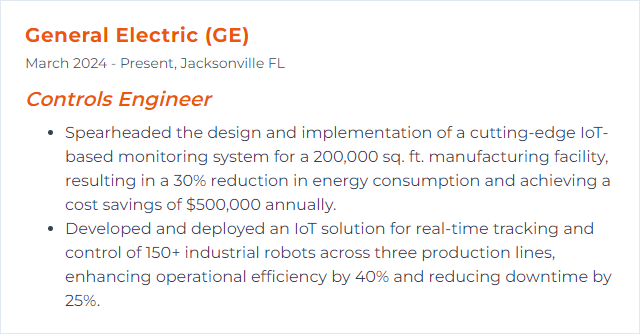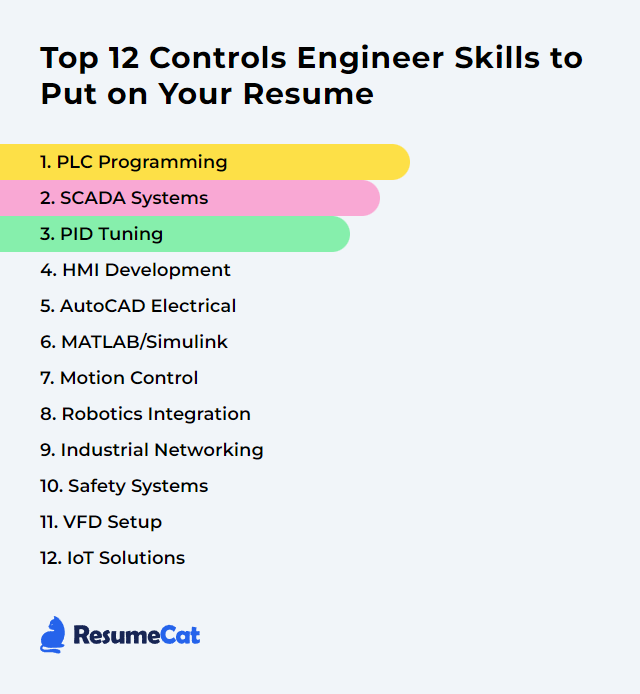Top 12 Controls Engineer Skills to Put on Your Resume
Hiring teams move fast. Your resume has to punch through the noise. For controls engineers, raw technical chops aren’t enough; employers also want proof you can architect, tune, and safeguard automated systems that run every hour of every shift. Build your story around skills that show impact, clarity, and steady control under real-world constraints.
Controls Engineer Skills
- PLC Programming
- SCADA Systems
- PID Tuning
- HMI Development
- AutoCAD Electrical
- MATLAB/Simulink
- Motion Control
- Robotics Integration
- Industrial Networking
- Safety Systems
- VFD Setup
- IoT Solutions
1. PLC Programming
PLC programming means writing, organizing, and maintaining logic that controls machines and processes. You translate requirements into reliable sequences that keep production humming and faults contained.
Why It's Important
It’s the backbone of industrial automation. Good PLC code boosts uptime, catches edge cases, and makes changeovers painless while keeping operators and equipment safe.
How to Improve PLC Programming Skills
Grow depth and speed without sacrificing rigor.
Nail the fundamentals: I/O maps, scan cycles, task priorities, memory types, and diagnostics. Know what runs when, and why.
Fluent in core languages: Ladder, function block, structured text. Pick the right tool for the logic at hand.
Practice with simulations: Build small plants-in-a-box. Stress test interlocks, alarms, and abnormal sequences.
Standardize: Reusable function blocks, naming conventions, clear comments, version control. Future you will thank you.
Design for maintenance: Add diagnostics, latched faults, timestamps, and clear HMI messages. Troubleshooting should be quick, not cryptic.
Document changes: Keep a changelog tied to tested releases. Track what changed, where, and why.
Benchmark on real hardware: Validate scan times, comms loads, and failover behavior, not just logic correctness.
How to Display PLC Programming Skills on Your Resume
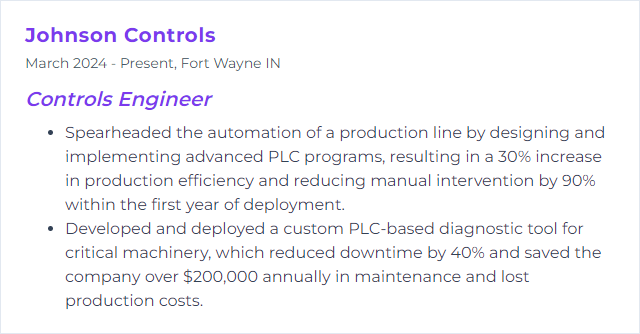
2. SCADA Systems
SCADA platforms collect, visualize, and command data from distributed assets. They provide real-time situational awareness and centralized control.
Why It's Important
You can’t control what you can’t see. SCADA brings alarms, trends, and commands into one place, boosting efficiency, safety, and response times.
How to Improve SCADA Systems Skills
Make it fast, resilient, and secure.
Engineer for reliability: Redundant servers, redundant comms, watchdogs, and graceful degradation for loss-of-signal scenarios.
Harden security: Role-based access, least privilege, encrypted links, secure remote access, rigorous patching, and audit trails aligned with industrial cybersecurity standards.
Optimize performance: Right-size polling rates, compress data where appropriate, and separate control from historian loads.
Alarm management: Prioritize, shelve with reason, add deadbands and delay-on timers. Reduce noise, surface what matters.
Historian and analytics: Trend critical KPIs, build dashboards, and apply alerts on derived metrics for early anomaly detection.
Operator-centered design: High-contrast layouts, consistent navigation, clear states, and sane color use. Train and test with real users.
How to Display SCADA Systems Skills on Your Resume
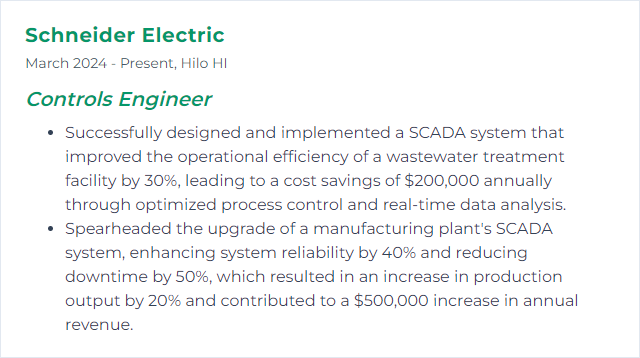
3. PID Tuning
PID tuning adjusts proportional, integral, and derivative gains so loops respond swiftly, stay stable, and meet accuracy targets under disturbance.
Why It's Important
Sharp control loops cut scrap, protect equipment, and keep processes in-spec. Sloppy tuning does the opposite.
How to Improve PID Tuning Skills
Methodical, measurable, iterative.
Establish a baseline: Identify process dynamics (dead time, time constants, gain). Start from a proven heuristic such as Ziegler–Nichols or better yet a conservative, low-overshoot rule set.
Work P first: Increase until oscillation flirts, then back off. Watch rise time and steady error.
Layer in I: Kill steady-state error gradually. Guard against windup with limits and bumpless transfer.
Use D carefully: Tame overshoot and quick disturbances. Filter noise; don’t amplify it.
Test edge cases: Load swings, setpoint steps, disturbances. Validate both speed and robustness.
Retune as systems age: Valves stick, friction creeps, processes drift. Schedule reviews.
How to Display PID Tuning Skills on Your Resume

4. HMI Development
HMI development turns system states and controls into visuals operators can trust and act on quickly, without guesswork.
Why It's Important
Clear interfaces prevent mistakes, shorten downtime, and let teams spot issues before they snowball.
How to Improve HMI Development Skills
Design for the real world, not just a screen.
Study the workflow: Shadow operators. Identify critical tasks, typical errors, and time-sensitive decisions.
Display hierarchy: Overviews for awareness, detail for diagnosis, and drill-downs for action. Keep navigation predictable.
Consistent visual language: Standard symbols, restrained color, and meaningful trends. Red means alarm; don’t waste it elsewhere.
Alarm philosophy: Severity tiers, concise messages, and action guidance. No floods. No mysteries.
Accessibility and performance: Fast loads, responsive layouts, and legible text at a distance under harsh lighting.
Iterate with users: Prototype, test, refine. Collect feedback and measure response times on typical tasks.
How to Display HMI Development Skills on Your Resume
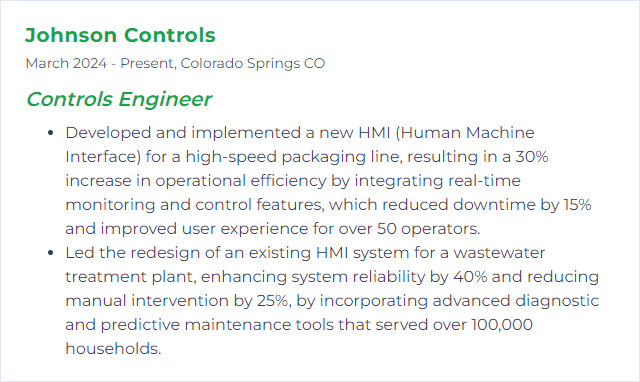
5. AutoCAD Electrical
AutoCAD Electrical accelerates creation of schematics, wiring diagrams, and panel layouts using symbol libraries, cross-references, and automated reports.
Why It's Important
You deliver accurate drawings faster, reduce rework, and keep documentation synchronized with the build.
How to Improve AutoCAD Electrical Skills
Make the tool work for you.
Template everything: Title blocks, layers, plot styles, wire types, and drawing standards. Consistency erases friction.
Master libraries: Curate symbols and manufacturer parts. Keep catalog data tidy and searchable.
Automate the tedious: Wire numbering, cross-referencing, I/O assignments, BOMs, and terminal plans. Generate reports directly from the design.
Panel-model alignment: Tie schematics to panel layouts and enclosure constraints. Check clearance, heat, and routing.
Revision control: Cloud or local, but disciplined. Mark deltas, track approvals, and archive releases.
QA checklists: Validate device tags, wire types, fuse sizing, and grounding before signoff.
How to Display AutoCAD Electrical Skills on Your Resume
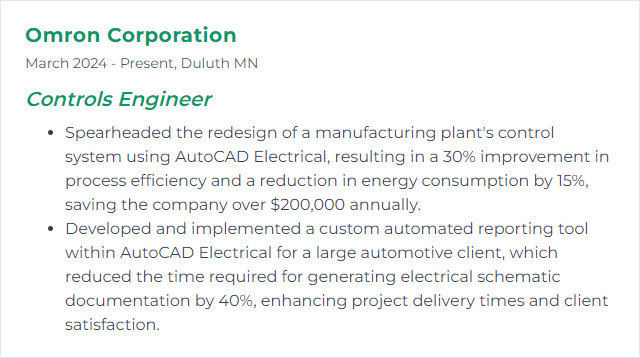
6. MATLAB/Simulink
MATLAB/Simulink lets you model plants, design controllers, simulate scenarios, and validate behavior before touching a line on the shop floor.
Why It's Important
Virtual prototypes catch problems early, shorten commissioning, and produce data-backed decisions on controller design.
How to Improve MATLAB/Simulink Skills
Model with intent; test with rigor.
Model fidelity first: Capture true dynamics—dead time, nonlinearities, saturations, friction—so simulation matches reality.
Toolbox depth: Learn control design, system identification, optimization, and code generation workflows end to end.
Automated tuning: Use optimization-based methods for PID and state-space controllers, then validate with step and disturbance tests.
Hardware in the loop: Integrate HIL/MIL/SIL setups where practical. Close the loop on assumptions.
Versioned experiments: Parameter sweeps, scripted runs, and saved seeds. Reproduce results on demand.
Bridge to implementation: Match sample times, numeric ranges, and constraints with the target PLC or embedded controller.
How to Display MATLAB/Simulink Skills on Your Resume
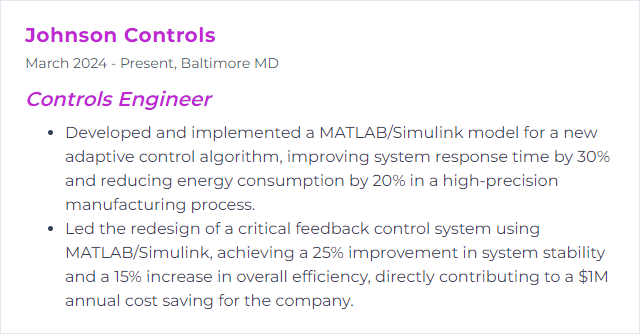
7. Motion Control
Motion control governs position, speed, and acceleration with precision, coordinating drives, motors, feedback devices, and trajectories.
Why It's Important
Accuracy and throughput hinge on smooth profiles, tight feedback, and robust control—especially in robotics, CNC, and packaging.
How to Improve Motion Control Skills
Chase precision without chasing noise.
Characterize the mechanics: Inertia, backlash, compliance, friction. Measure, don’t guess.
Feedback quality: Choose encoders/resolvers with appropriate resolution and mounting. Calibrate and filter sensibly.
Profile planning: Use S-curve or jerk-limited profiles to balance speed and vibration.
Controller tuning: Tune current, speed, and position loops in the right order. Validate following error and settling.
Commission the drive stack: Motor nameplate, commutation, inertia estimation, autotuning, and safety limits.
EMI discipline: Shielding, grounding, cable routing, and separation from sensitive I/O.
How to Display Motion Control Skills on Your Resume
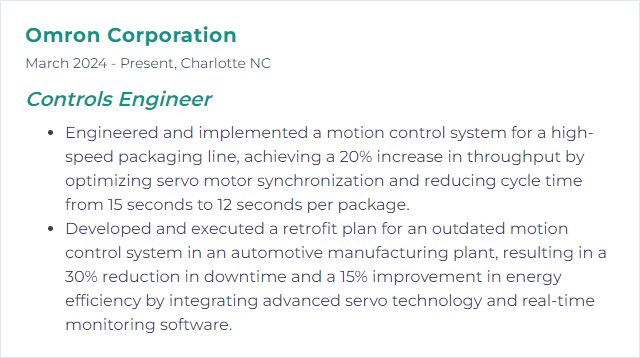
8. Robotics Integration
Robotics integration connects robots to conveyors, tooling, safety systems, and higher-level control, then stitches it all into coherent sequences.
Why It's Important
Well-integrated cells hit takt time, minimize downtime, and adapt fast to product changes.
How to Improve Robotics Integration Skills
Think system, not silo.
Cell architecture first: Define interfaces, message sets, and fault-handling from the top down.
Offline programming: Simulate reach, singularities, cycle time, and collision envelopes before hardware arrives.
Handshakes that fail safe: Clear states between PLC, robot, vision, and peripherals. Timeouts, retries, and recovery paths documented.
Tooling and payload: Verify CG, inertia, grip force, and compliance. Teach points that survive tolerances.
Vision and calibration: Robust lighting, repeatable fixtures, and routine re-cal routines for drift.
Safety compliance: Risk assessments, performance levels (PL/SIL), interlocks, and validated stop categories.
How to Display Robotics Integration Skills on Your Resume
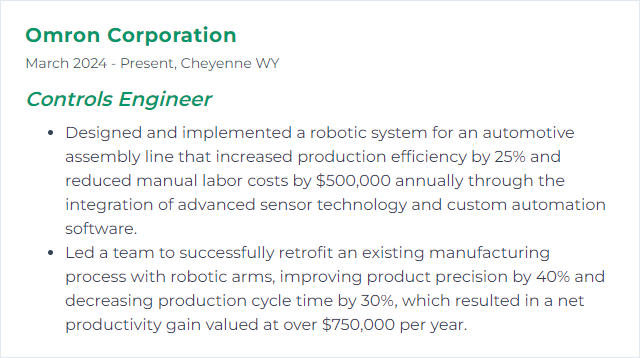
9. Industrial Networking
Industrial networks connect PLCs, HMIs, drives, sensors, and historians using deterministic protocols and hardened infrastructure.
Why It's Important
Reliable comms mean fewer ghosts in the machine. Good design shrinks latency, improves diagnostics, and constrains failures.
How to Improve Industrial Networking Skills
Engineer like uptime depends on it—because it does.
Topology and segmentation: Star or ring with clear zones and conduits. Separate control, safety, and business traffic.
Protocol fit: Choose appropriate fieldbuses/Ethernet protocols for determinism, bandwidth, and interoperability.
Redundancy: Redundant switches, power, and links. Fast failover mechanisms. Test the cutover, not just the diagram.
Addressing and naming: Predictable IP plans, switch configs, and device tags. Documentation that matches the rack, not just the plan.
Security controls: Firewalls, VLANs, whitelists, monitored remote access, and patch regimes aligned to industrial standards.
Monitoring: Syslogs, SNMP, port mirroring, and baseline trends to spot trouble early.
How to Display Industrial Networking Skills on Your Resume
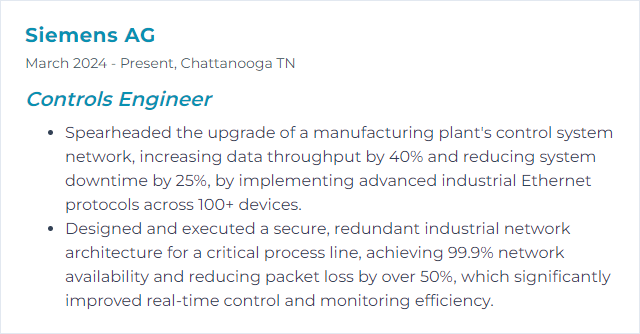
10. Safety Systems
Safety systems combine engineered controls, interlocks, and procedures to reduce risk to people, equipment, and the environment.
Why It's Important
Nothing matters more than going home safe. Solid safety engineering also protects uptime and compliance.
How to Improve Safety Systems Skills
Design, verify, and keep verifying.
Risk assessment first: Identify hazards, estimate risk, and select risk reduction measures following recognized methodologies.
Functional safety lifecycle: Define safety requirements, design to required SIL/PL, and validate performance with proof tests.
Safety PLCs and relays: Architect dual-channel, monitored circuits with diagnostics and clear fault reactions.
Interlock strategy: Guard doors, light curtains, E-stops, safe torque off, and safe speed functions verified end to end.
Alarm and ESD philosophy: Distinguish warnings from trips. Ensure orderly shutdowns and documented restart procedures.
Training and drills: Operators and maintenance need clarity on hazards, resets, and emergency responses.
How to Display Safety Systems Skills on Your Resume
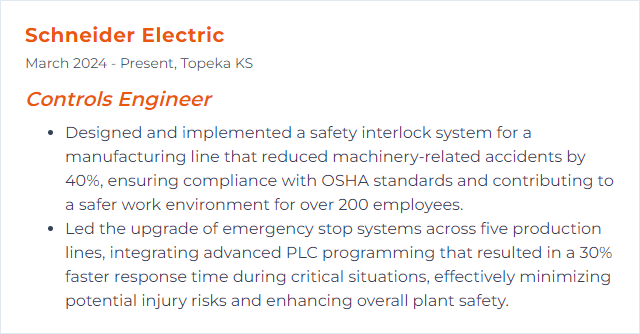
11. VFD Setup
VFD setup configures drives to command motor speed, torque, and direction while coordinating I/O, protections, and control modes.
Why It's Important
Proper setup saves energy, reduces mechanical stress, and keeps processes steady under changing loads.
How to Improve VFD Setup Skills
Treat it like a system, not a parameter dump.
Match the motor: Accurate nameplate data, auto-tune, and correct control method (V/f, sensorless vector, or vector with feedback).
Wiring and grounding: Shielded motor leads, proper bond points, and separation from sensitive signals to tame EMI.
Protections: Current limits, thermal models, accel/decel ramps, flying start, and stall prevention set appropriately.
Built-in PID: When using process control, tune conservatively and add anti-windup and filters.
Harmonics and power quality: Line reactors, DC chokes, or filters as needed. Verify THD against site limits.
Cooling and enclosure: Respect ambient, spacing, and airflow. Derate when the math says so.
Firmware and logs: Update thoughtfully and archive parameter sets. Enable fault histories for faster troubleshooting.
Networked drives: Secure access, clear addressing, and deterministic command/feedback mapping.
How to Display VFD Setup Skills on Your Resume
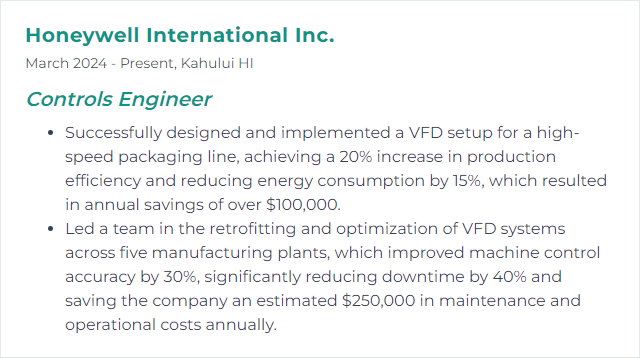
12. IoT Solutions
IoT solutions weave sensors, controllers, and cloud or edge services into live feedback loops for monitoring, analytics, and remote action.
Why It's Important
Real-time data turns maintenance into foresight and reveals process improvements that hide in averages.
How to Improve IoT Solutions Skills
Reliable, secure, interoperable.
Right-size connectivity: Choose protocols and transports that fit bandwidth, latency, and power limits. Plan for unreliable links.
Edge first: Preprocess, filter, and aggregate at the edge to cut noise and cost. Only ship what’s useful.
Strong security posture: Device identity, encrypted channels, secure boot, signed updates, and principle of least privilege.
Data models and semantics: Standardize payloads and metadata so systems can talk cleanly across vendors.
Lifecycle management: Provisioning, fleet updates, monitoring, and decommissioning with auditability throughout.
How to Display IoT Solutions Skills on Your Resume
